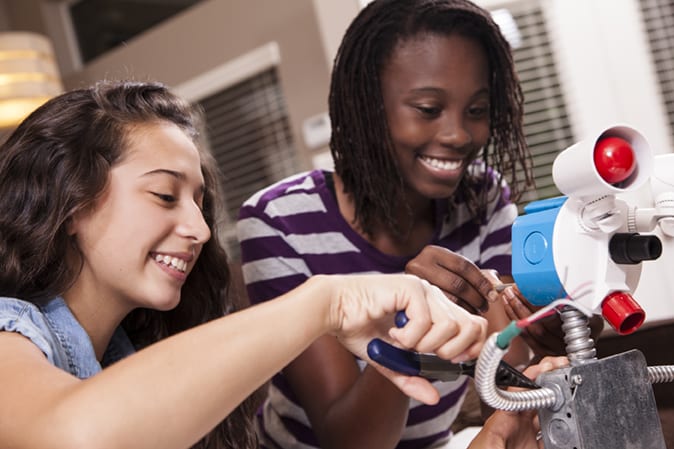
In 10th grade, my high school math teacher casually told me that I “just wasn’t a math person.” I believed him immediately. Why wouldn’t I? He was the expert. I decided this was an inherent fact about myself, and the next year, I dropped out of my advanced math class when I started to struggle. In college, I avoided math at all costs. That comment has stayed with me to this day.
I am not alone in my experience. Many people similarly develop beliefs they are not “math/science people” from small moments or interactions across their P-12 experience. Black and Latino students, as well as girls, often face many challenges in STEM classrooms, including the message that they do not belong. When students come across difficulty or low expectations, and do not have support, they may develop low self-perceptions of selves as science or math learners. And reliance on one eligibility metric to move students into accelerated coursework, such as educator recommendation or one standardized test score, can result in the under-enrollment of Black and Latino students and students from low-income backgrounds into advanced classes.
Science, technology, engineering, and math (STEM) careers are expected to grow at twice the rate of other jobs in the next decade. Yet Black and Latino workers, as well as women, remain underrepresented in STEM careers, and the country is unlikely to have all the STEM workers it needs while these inequities remain.
Responding to disparities, the Department of Education launched a “YOU Belong in STEM” initiative in fall 2022 to enhance STEM education for all young people. The initiative has three goals:
- Ensure all P-16 students have access to and benefit from rigorous, culturally relevant, and joyful STEM learning
- Support STEM educators by strengthening opportunities to join, grow, and stay in the STEM teaching field
- Encourage education and youth-serving systems to invest American Rescue Plan and other federal, state, and local funds in STEM
I attended the first “YOU Belong in STEM” National Coordinating Conference in early December, joining government agencies, non-governmental and community-based organizations, students, educators, and leaders across the public and private sectors who believe that all students deserve positive STEM experiences. This belief echoes findings in our 2022 report and video, Shut Out: Why Black and Latino Students Are Under-Enrolled in AP STEM Courses, and we will continue to advocate for expanding access to positive, engaging experiences in P-12 STEM classrooms, to set all students up for success in college and careers.
Positive experiences in P-12 math and science classrooms means students are more likely to choose STEM majors in college. To address our immanent STEM pipeline crisis, we need to tackle this issue early and often. Here are three proven ways to increase belongingness in STEM classrooms:
Support diverse educators. Studies find that teachers of color are more likely to create a positive school climate that supports students of color in taking STEM courses by serving as a role model and reaching out to high-achieving students of color to encourage them to enroll in advanced courses. This also goes for teachers from the community they teach in. Students do not all have access points to develop positive relationships with aspirational role models in STEM, such as doctors, engineers, professors, and scientists. When students have teachers that look like them and come from their communities, they may be able to relate to the content and envision themselves in STEM futures.
Integrate STEM with career-connected and work-based learning. More high-quality, relevant, and career-connected STEM courses can provide students with opportunities to connect what they are learning to career pathways. Half of all STEM jobs are open to workers with less than a bachelor’s degree. STEM also includes agriculture, environmental sciences, data sciences, automotive mechanics, web development, plumbing, and many other career options that pay a living wage.
Mentors and role models help foster a sense of belonging. This is particularly important for students of color, girls, and students from low-income backgrounds. When students are one of a low number of their gender and/or racial/ethnicity group in a STEM course, or they do not see themselves reflected in their curriculum or teachers, students may not see themselves as a part of that community, may feel isolated, and/or their skills in STEM may not be recognized. However, a successful STEM role model or mentor can signal to Black and Latino students and girls that they can imagine a career in STEM, or they may even serve as allies or support systems when students experience doubt or struggle.
To prepare our future leaders, neighbors, and workers who can understand and solve some of the complex challenges of today and tomorrow, our school system needs educators to believe that all students are “math people” and “science people,” including students who may not be college-bound. Beyond meeting the demands of an evolving workforce, all students deserve to feel like they belong in STEM and can see themselves succeed.
-------------------------
By: Kristen Hengtgen
Title: Who Belongs in STEM?
Sourced From: edtrust.org/the-equity-line/who-belongs-in-stem/
Published Date: Tue, 03 Jan 2023 04:02:19 +0000
Read More
Did you miss our previous article...
https://prohealthsciences.com/pandemic-news/these-are-the-15-best-books-i-read-in-2022
 General Health and WellnessFitness and ExerciseSupplements and VitaminsPandemic NewsVideosPrivacy PolicyTerms And Conditions
General Health and WellnessFitness and ExerciseSupplements and VitaminsPandemic NewsVideosPrivacy PolicyTerms And Conditions
